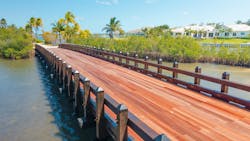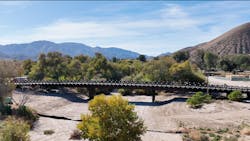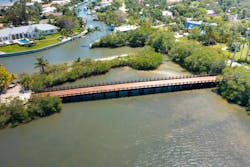Wooden Wonders
Timber is part of the foundation of American infrastructure. Sometimes used for pedestrian and bike bridges, they are far from nostalgic throwbacks. Modern timber bridges are high-performance, environmentally responsible structures that meet the demands of 21st-century infrastructure. From flood-resilient crossings in desert terrains to low-impact spans in protected wetlands, timber bridges are relevant and essential to the pursuit of resilient, sustainable design.
Two recent examples showcase the ongoing relevance of timber bridges: the Thousand Trails Bridge in Acton, Cali. and the Mandalay Bridge, which sits on a private property in coastal South Florida. Designed and built by York Bridge Concepts (YBC), these structures illustrate timber’s potential in arid and aquatic environments. Each bridge blends technical performance with eco-sensitive construction, proving that timber bridges can be resilient, sustainable and beautiful.
Designing, crafting, and building a timber bridge is an art form. YBC, which celebrates its 40th anniversary this year, and construction companies like Western Wood Structures, Milbocker and Sons, and several others have carried on this tradition and modernized it.
With thoughtful engineering and innovative construction methods, timber plays a significant role in modern infrastructure.
A Timeless Material
Timber bridges have deep roots in American infrastructure. In the 19th century, timber was a primary building material thanks to its abundance and ease of use, and it became the basis for countless covered bridges that connected farmers in rural communities.
Timber bridges were known for their ingenuity. Builders developed a variety of truss styles—like the Town lattice, Burr arch, and Howe truss—to increase span and load capacity.
The use of roofs and sidewalls protected structural timbers from the weather, significantly extending their lifespan.
In fact, some 19th-century wooden bridges are still in service today, a testament to their design and craftsmanship.
As steel and concrete became dominant materials in the 20th century, timber never disappeared. In forested and rural regions, wood remained a cost-effective and accessible material.
Timber likely won’t be used as part of an interstate or to span the Mississippi River. But modern engineering and treatments, such as pressure-treated glulam beams, have revived timber as a viable choice in certain situations.
Timber can deliver beauty and character, as well as strength, durability and environmental compatibility.
Greenly performs Life Cycle Analysis (LCA) for projects. YBC saved over 32,000 kilograms of carbon dioxide equivalent in 2024, according to Greenly’s carbon analysis.
Timber construction also is efficient in cost and construction time when compared to steel or concrete in specific applications, particularly in remote areas where heavy equipment access is limited.
Resilience in the High Desert
After flash flooding in 2023 destroyed a culvert system at the Thousand Trails Soledad Canyon RV Resort in Acton, Cali., access to parts of the park was lost.
To restore that access, YBC designed and built a 320-foot-long timber bridge in under three months—a feat accomplished by a crew of seven master craftsmen working in a challenging desert environment.
The bridge, supported by glulam Douglas Fir stringers and treated timber piles, includes one 80-foot span, two 60-foot spans and six 20-foot spans.
With an HS20-44 load rating, the bridge can accommodate everything from RVs to emergency vehicles. Its elevated design replaces the failed below-grade culvert system, restoring the watercourse to a natural state and creating habitat for endangered fish and amphibians.
“The elimination of the concrete culverts and installation of an above grade timber bridge has allowed the watercourse to return to its natural state,” said Mike Sukel, director of asset management for Equity Lifestyle. “It also allowed for the restoration of native plant material which in turn created habitat for endangered fish and amphibian species.”
The Thousand Trails project exemplifies YBC’s deck-level (Top-Down) construction methodology, where bridge elements are assembled from the deck downward. This approach minimizes environmental disruption by keeping heavy equipment off sensitive land.
In this case, it allowed the bridge to be constructed above a dry riverbed without compromising the soil or existing vegetation.
Safety and durability were paramount, according to the team. The bridge meets California’s 100-year storm standards and includes non-slip surfaces, reinforced anchoring for seismic resilience and AASHTO-compliant guardrails. The open-span design also mitigates future flood risks.
“The previous infrastructure failed during flooding,” said Brian Kennedy, director of bridge consultancy at YBC. “This bridge was designed so it won’t.”
“The timber bridge fits well with the natural environment and feeling of the campground,” Sukel said. “A steel or concrete bridge would seem out of pace or too imposing.”
Community impact was another key outcome. The park had previously been partially cut off due to infrastructure failure. Now, access is restored not only for guests but for emergency services as well.
The bridge’s presence also elevates the visual character of the park, becoming a landmark in its own right.
Harmony in a Coastal Ecosystem
Tucked within the lush tropical landscape of coastal South Florida, the Mandalay Vehicular Timber Bridge stands as a striking example of how infrastructure can coexist with delicate environments.
At 262 feet in length, this timber bridge replaces a deteriorating structure on a private estate, crossing a shallow tidal estuary teeming with protected mangroves and Johnson seagrass.
From the start, the project posed considerable environmental and logistical challenges. The bridge had to comply with strict environmental protections for native mangroves and Johnson seagrass. Traditional construction with heavy equipment would have posed significant ecological risks, so YBC again used its deck-level methodology.
This method allowed crews to dismantle the existing 50-year-old bridge and construct the new one using hand tools and lightweight equipment placed directly on the deck, avoiding disruption to the seabed.
The repetitive 14.55-foot spans distributed weight evenly across the structure, minimizing impact on the soft muck and coquina rock below.
“This project exemplifies ecotecture at its finest,” said Drew Dancey, YBC’s director of construction. “We used sustainably harvested Southern Yellow Pine and Jatoba hardwood, which not only withstand the saltwater environment but also showcase natural beauty.”
The bridge’s sleek, understated design integrates seamlessly with the tropical surroundings. Oil coatings and pile wraps protect the wood from UV rays, saltwater and rain, while stainless steel hardware resists corrosion.
“We had to be mindful of everything—from manatees in the water to low-hanging oak limbs during daily mobilization,” said Dancey.
Environmental monitoring was constant. A third-party ecologist conducted daily assessments, and construction paused anytime protected wildlife entered the area. Waste was meticulously managed: all wood shavings were vacuumed and disposed of to ensure zero contamination in the wetland ecosystem.
The Mandalay project also tackled challenging geography. Foundations had to be precisely drilled into coquina rock beneath soft muck, requiring surgical precision. Repetitive span design helped distribute load while minimizing settlement risk.
The result is a bridge that enhances property access while leaving the natural environment undisturbed.
“The surrounding ecosystems are still thriving post-construction,” Dancey said.
Timber’s Modern Comeback
The success of these two projects speaks to the broader potential of timber bridges in today’s infrastructure landscape. Advancements in pressure-treated wood, glulam technology and construction methods have extended the life expectancy of timber bridges to 75 years or more, according to YBC.
“We’re creating long-term infrastructure that also serves as a carbon bank,” said Kennedy. “Every timber bridge we build helps sequester carbon, making a positive contribution to climate change mitigation.”
Beyond sustainability, timber bridges offer a powerful blend of aesthetics and functionality. They are especially well-suited for parks, resorts, private communities and environmentally sensitive areas where visual harmony and ecological preservation are paramount.
YBC’s deck-level construction approach has proven to be effective in desert and estuarial environments. By building from the top down and using lightweight materials and equipment, projects can be completed faster, safer and with less environmental impact than traditional bottom-up methods.
Timber also provides versatility in design. The Mandalay and Thousand Trails bridges were customized to suit their settings, using regionally appropriate timber species, legacy series coatings, and site-specific structural enhancements.
A Collaborative Model
The bridges were the result of close coordination among designers, engineers, regulatory agencies and on-site crews. For Thousand Trails, that meant coordinating geotechnical, environmental and hydraulic consultants to meet California permitting requirements.
For Mandalay, it involved balancing daily inspections, strict privacy protocols and marine habitat protection—all while mobilizing from a staging area nearly a mile away.
The in-house project management model adopted by YBC played a key role in these successes. All aspects—from design and procurement to construction and quality control—were handled by a single team, reducing delays and ensuring accountability.
Safety protocols were strictly enforced across both projects. Workers were tethered at all times while elevated, wore life vests when over water, and followed all OSHA standards.
These practices, combined with YBC’s proactive planning and real-time adaptability, resulted in zero incidents across both job sites.
Building Toward Resilience
As the United States confronts aging infrastructure and growing climate challenges, timber bridges may offer a compelling alternative, especially in locations where sustainability, aesthetics and ecological sensitivity are essential.
Projects like Thousand Trails and Mandalay show that wood is not a relic of the past—it’s a forward-looking material capable of meeting today’s highest standards for performance, safety and design.
“These bridges are more than crossings. They’re enduring symbols of how infrastructure can respect the environment, honor tradition, and meet modern needs all at once,” Kennedy said. RB
With an HS20-44 load rating, the bridge can accommodate everything from RVs to emergency vehicles. Its elevated design replaces the failed below-grade culvert system, restoring the watercourse to a natural state and creating habitat for endangered fish and amphibians.
“It’s become an iconic feature of the park,” said Brian Kennedy, director of bridge consultancy at YBC. “The bridge blends beautifully with the natural desert surroundings while offering critical functionality and flood resilience.”
The Thousand Trails project exemplifies YBC’s Deck-Level (Top-Down) Construction Methodology, where bridge elements are assembled from the deck downward. This approach minimizes environmental disruption by keeping heavy equipment off sensitive land.
In this case, it allowed the bridge to be constructed above a dry riverbed without compromising the soil or existing vegetation.
Safety and durability were paramount, according to the team. The bridge meets California’s 100-year storm standards and includes non-slip surfaces, reinforced anchoring for seismic resilience and AASHTO-compliant guardrails.
“The previous infrastructure failed during flooding,” Kennedy said. “This bridge was designed so it won’t.”
Local sentiment supports the timber approach.
“A steel or concrete bridge would seem out of place,” said a representative from the campground. “The timber structure feels like a natural part of the landscape and allows us to restore native plant material.”
Community impact was another key outcome. The park had previously been partially cut off due to infrastructure failure. Now, access is restored not only for guests but for emergency services as well.
The bridge’s presence also elevates the visual character of the park, becoming a landmark in its own right.
Mandalay: Harmony in a Coastal Ecosystem
Tucked within the lush tropical landscape of South Florida, the Mandalay Vehicular Timber Bridge stands as a striking example of how infrastructure can coexist with delicate environments.
At 262 feet in length, this timber bridge replaces a deteriorating structure on a private estate, crossing a shallow tidal estuary teeming with protected mangroves and Johnson seagrass.
This method allowed crews to dismantle the existing 50-year-old bridge and construct the new one using hand tools and lightweight equipment placed directly on the deck, avoiding disruption to the seabed.
The repetitive 14.55-foot spans distributed weight evenly across the structure, minimizing impact on the soft muck and coquina rock below.
“This project exemplifies ecotecture at its finest,” said Drew Dancey, YBC’s director of construction. “We used sustainably harvested Southern Yellow Pine and Jatoba hardwood, which not only withstand the saltwater environment but also showcase natural beauty.”
The bridge’s sleek, understated design integrates seamlessly with the tropical surroundings. Oil coatings protect the wood from UV rays, saltwater and rain, while stainless steel hardware resists corrosion.
“We had to be mindful of everything—from manatees in the water to low-hanging oak limbs during daily mobilization,” said Dancey.
Environmental monitoring was constant. A third-party ecologist conducted daily assessments, and construction paused anytime protected wildlife entered the area. Waste was meticulously managed: all wood shavings were vacuumed and disposed of to ensure zero contamination in the wetland ecosystem.
The Mandalay project also tackled challenging geography. Foundations had to be precisely drilled into coquina rock beneath soft muck, requiring surgical precision. Repetitive span design helped distribute load while minimizing settlement risk.
The result is a bridge that enhances property access while leaving the natural environment undisturbed.
“The surrounding ecosystems are still thriving post-construction,” Dancey said.
Timber’s Modern Comeback
The success of these two projects speaks to the broader potential of timber bridges in today’s infrastructure landscape. Advancements in pressure-treated wood, glulam technology and construction methods have extended the life expectancy of timber bridges to 75 years or more, according to YBC.
“We’re creating long-term infrastructure that also serves as a carbon bank,” said Kennedy. “Every timber bridge we build helps sequester carbon, making a positive contribution to climate change mitigation.”
Beyond sustainability, timber bridges offer a powerful blend of aesthetics and functionality. They are especially well-suited for parks, resorts, private communities, and environmentally sensitive areas where visual harmony and ecological preservation are paramount.
YBC’s Deck-Level Construction approach has proben to be effective in desert and estuarial environments. By building from the top down and using lightweight materials and equipment, projects can be completed faster, safer and with less environmental impact than traditional bottom-up methods.
Timber also provides versatility in design. The Mandalay and Thousand Trails bridges were customized to suit their settings, using regionally appropriate timber species, Legacy Trim level coatings, and site-specific structural enhancements.
A Collaborative Model
The bridges were the result of close coordination among designers, engineers, regulatory agencies and on-site crews. For Thousand Trails, that meant coordinating geotechnical, environmental and hydraulic consultants to meet California permitting requirements.
For Mandalay, it involved balancing daily inspections, strict privacy protocols and marine habitat protection—all while mobilizing from a staging area nearly a mile away.
The in-house project management model adopted by YBC played a key role in these successes. All aspects—from design and procurement to construction and quality control—were handled by a single team, reducing delays and ensuring accountability.
Safety protocols were strictly enforced across both projects. Workers were tethered at all times while elevated, wore life vests when over water, and followed all OSHA standards. These practices, combined with YBC’s proactive planning and real-time adaptability, resulted in zero incidents across both job sites.
Building Toward Resilience
As the United States confronts aging infrastructure and growing climate challenges, timber bridges may increasingly offer a resilient and environmentally sound solution.
Projects like Thousand Trails and Mandalay show that wood is not a relic of the past—it’s a forward-looking material capable of meeting today’s highest standards for performance, safety and design.
Kennedy spoke to the legacy of the bridges and timber construction at large.
“These bridges are more than crossings. They’re enduring symbols of how infrastructure can respect the environment, honor tradition, and meet modern needs all at once,” he said. RB


